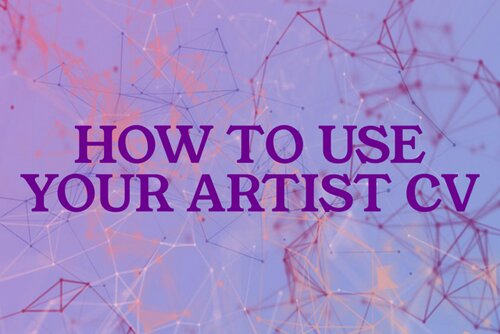by Carolyn Edlund
How can artists use their professional CV’s to gain business and increase career opportunities? Here’s a list of ways to make your CV work for you.

As an artist, you might think your portfolio does all the talking. But a good CV (curriculum vitae) can open doors your artwork alone might not. If you haven’t yet created your CV or you feel that it needs a makeover, check out my article Write Your Artist CV to get started.
Once you have a professional CV completed to your satisfaction, here are 12 ways to use it to further your art career:
1. Gallery Representation
When approaching galleries, your CV shows them you’re serious about your career and understand their needs when considering new talent. In addition to your portfolio, your application package should include your previous exhibitions, education, and any press coverage, which all factor into your CV. Galleries want artists who are professional and have a track record they can talk about with collectors.
2. Commission Proposals
When someone is thinking about paying you to create something special, they want proof you can deliver. Your CV highlights similar projects you’ve completed, showing potential clients you have the experience to handle their commission.
3. Art Consultant Relationships
Art consultants help place artwork in commercial and high-end residential collections and spaces. A clear and relevant CV gives them a look into your experience in their industry so they can feel confident you will create and deliver artwork for their projects on time and on budget. Include it as part of the package you submit to work with these influential trade members.
4. Client Communication
Meeting or communicating with a potential collector? A well-designed CV gives them something to take home besides your business card. Buyers don’t just purchase art; they are buying you, your story, your reputation and your talent as well. An impressive CV reminds them of your accomplishments and helps them feel confident in collecting your work. As you build credibility as an artist and share it via your CV, you will gain trust from customers of all types.
5. Competition Entries
Most art competitions ask for a CV along with your artwork. Judges use it to understand your background, expertise, recognition and commitment. Can a well-written CV make a difference in getting accepted? Absolutely! Make sure it’s updated with your latest achievements before you submit.
6. Increase Artist Credibility on Social
Elements of your CV content can be repurposed and used online in your professional profile on sites such as LinkedIn. Other websites that can lead to commission opportunities or seek inquiries are also good places to include your CV. Consistent information across platforms makes you look professional and easy to find online.
7. Art Website Credentials
Your website is your online headquarters that presents your portfolio, bio and brand narrative, experience and abilities. A CV is an integral part of the whole package, and can be placed on a page under the About section or even made available as a downloadable document.
8.Workshop/Teaching Opportunities
Interested in teaching, in person or online? Your CV should highlight any previous teaching experience, workshops you’ve led, or educational accomplishments that show you can guide others. Acting like a resume that is dedicated to your art career, your CV can identify you as the right candidate for a teaching position.
9. Residency Applications
Decision makers for artist residencies want to know you’ll make good use of their space and opportunity. Your CV should show how you’ve grown from previous residencies or collaborative experiences. This critical document can be one of the main deciding factors in selecting successful artists for desirable residencies.
10. Grant Applications
Grant committees look for artists who will use funding wisely. Your CV should emphasize achievements relevant to the grant’s focus, whether that’s community involvement, technical innovation, or artistic excellence. In fact, your background and experience are paramount in any grant application, so be sure to go over your CV in detail to make sure you are putting your best foot forward as a candidate.
11. Exhibition Applications
When applying for exhibitions, your art portfolio matters front and center. But, curators may also take a look at your CV to learn more about you that cannot be ascertained simply by viewing an image. Include your exhibition history, education, and any special techniques or approaches that make your work stand out to enhance your chances of being accepted.
12. Academic Positions
Art schools look for teaching candidates with both artistic accomplishments and educational credentials. Structure your CV to highlight both your creative practice and your ability to inspire students. These competitive opportunities need your most professional and detailed credentials.
Your artist CV is a living document that can serve you in different forms throughout your art career. Update it every time you complete a project, win an award, or participate in an exhibition. Keep different versions for different purposes, and always have it ready to share when opportunity knocks!




Speak Your Mind